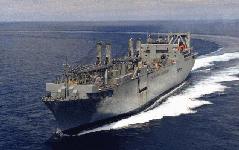
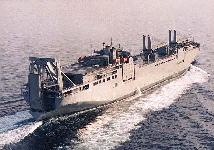
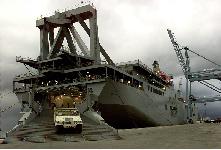
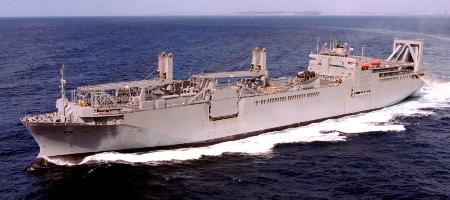



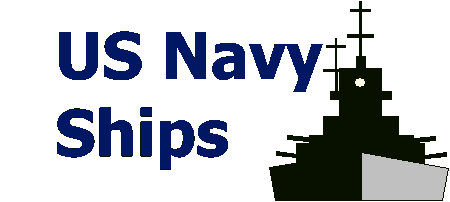
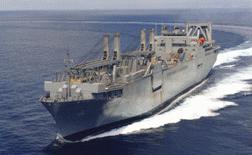 Military Sealift Command's newest class of ships � Large, Medium-speed, Roll-on/Roll-off Ships, or LMSR � will significantly expand the nation's sealift capability in the 1990s and beyond. Nineteen LMSRs will have been converted or built at U.S. shipyards by the year 2001. The LMSRs will provide afloat prepositioning of an Army heavy brigade�s equipment and a corps� combat support, as well as surge capability for lift of a heavy division�s equipment from the United States.
Military Sealift Command's newest class of ships � Large, Medium-speed, Roll-on/Roll-off Ships, or LMSR � will significantly expand the nation's sealift capability in the 1990s and beyond. Nineteen LMSRs will have been converted or built at U.S. shipyards by the year 2001. The LMSRs will provide afloat prepositioning of an Army heavy brigade�s equipment and a corps� combat support, as well as surge capability for lift of a heavy division�s equipment from the United States.
The need for additional military sealift ships was identified in a Congressionally-mandated study by the Joint Chiefs of Staff in the early 1990s. The Mobility Requirements Study focused on Department of Defense transportation during the Persian Gulf War. It highlighted the urgent need for greater sealift capacity to transport military equipment and supplies during wartime and other national contingencies. In response to the sealift shortfall, an ambitious Strategic Sealift Acquisition Program was introduced. Plans called for adding 19 LMSRs which will provide five million square feet of capacity early in the next century.
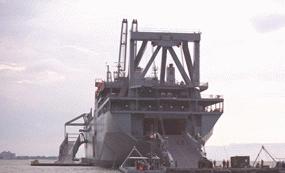 The LMSR program currently has 19 ships, 5 of which are conversions of existing commercial container vessels, and 14 of which will be newly constructed ships. All 19 ships use common cargo handling systems, procured by the Navy. LMSRs are being built by three contractors. A performance type procurement description was used, therefore specific ship configurations differ as the respective builders interpret the mission requirements.
During the initial Design Phase, the bidding shipyards conducted conceptual design studies in response to Navy-developed performance requirements and commercial standards. These concepts, along with additional design work by the Navy, were used to refine the performance requirements for use in the next phase of the program. In the Engineering Design Phase, five U.S. shipyards selected existing ships as conversion candidates and developed detailed proposals for their conversion into Large, Medium Speed RO/RO's (LMSR's) which met the refined requirements. At the end of this phase, two shipyards were authorized to proceed with the Detail Design and Conversion of five existing ships. On 30 July 1993, National Steel and Shipbuilding Company (NASSCO) was authorized to proceed with the Detail Design and Conversion of three existing containerships. The NASSCO project converts
three commercial "L" Class containerships to militarily useful RO/RO's for prepositioning and transport of tanks, trucks, and other military equipment. Two more ships were converted at
Newport News Shipbuilding and Dry Dock Company, Newport News, Virginia. These five roll-on/roll-off vessels are operated
by Bay Ship Management, Inc. under US Navy Military Sealift Command charter, and are manned by US Merchant Marine personnel.
LMSRs can carry an entire U.S. Army Task Force, including 58 tanks, 48 other track vehicles, plus more than 900 trucks and other wheeled vehicles. The ship carries vehicles and equipment to support humanitarian missions, as well as combat missions. The new construction vessels have a cargo carrying capacity of more than 380,000 square feet, equivalent to almost eight football fields. In addition, LMSRs have a slewing stern ramp and a removable ramp which services two side ports making it easy to drive vehicles on and off the ship. Interior ramps between decks ease traffic flow once cargo is loaded aboard ship. Two 110-ton single pedestal twin cranes make it possible to load and unload cargo where shoreside infrastructure is limited or nonexistent. A commercial helicopter deck was added for emergency, daytime landing.
The LMSR program currently has 19 ships, 5 of which are conversions of existing commercial container vessels, and 14 of which will be newly constructed ships. All 19 ships use common cargo handling systems, procured by the Navy. LMSRs are being built by three contractors. A performance type procurement description was used, therefore specific ship configurations differ as the respective builders interpret the mission requirements.
During the initial Design Phase, the bidding shipyards conducted conceptual design studies in response to Navy-developed performance requirements and commercial standards. These concepts, along with additional design work by the Navy, were used to refine the performance requirements for use in the next phase of the program. In the Engineering Design Phase, five U.S. shipyards selected existing ships as conversion candidates and developed detailed proposals for their conversion into Large, Medium Speed RO/RO's (LMSR's) which met the refined requirements. At the end of this phase, two shipyards were authorized to proceed with the Detail Design and Conversion of five existing ships. On 30 July 1993, National Steel and Shipbuilding Company (NASSCO) was authorized to proceed with the Detail Design and Conversion of three existing containerships. The NASSCO project converts
three commercial "L" Class containerships to militarily useful RO/RO's for prepositioning and transport of tanks, trucks, and other military equipment. Two more ships were converted at
Newport News Shipbuilding and Dry Dock Company, Newport News, Virginia. These five roll-on/roll-off vessels are operated
by Bay Ship Management, Inc. under US Navy Military Sealift Command charter, and are manned by US Merchant Marine personnel.
LMSRs can carry an entire U.S. Army Task Force, including 58 tanks, 48 other track vehicles, plus more than 900 trucks and other wheeled vehicles. The ship carries vehicles and equipment to support humanitarian missions, as well as combat missions. The new construction vessels have a cargo carrying capacity of more than 380,000 square feet, equivalent to almost eight football fields. In addition, LMSRs have a slewing stern ramp and a removable ramp which services two side ports making it easy to drive vehicles on and off the ship. Interior ramps between decks ease traffic flow once cargo is loaded aboard ship. Two 110-ton single pedestal twin cranes make it possible to load and unload cargo where shoreside infrastructure is limited or nonexistent. A commercial helicopter deck was added for emergency, daytime landing.
The LMSR ships are Large (950 feet long, 106 feet wide, 55,000 long ton displacement), Medium Speed (24 knots), Roll-on/Roll-off (RO/RO) vessels. The sealift ships will be capable of self-sustained RO/RO and Lift on/Lift off (LO/LO) operations at a pier and in a Logistics-Over-the Shore (LOTS) scenario through stern and side port ramps to a RO/RO Discharge Facility (RRDF). In addition, the LMSR will be capable of self-sustained LO/LO cargo operations in a LOTS scenario by interfacing with lighterage. The LMSR ships are not armed, and do not have a combat system. They do have C3I suite sufficient to perform their intended mission in conjunction with other Naval vessels.
Although their official homeport is Norfolk, VA, the ships of Afloat Prepositioning Ships Squadron Four are always forward-deployed to the Persian Gulf and have no tie whatsoever to Virginia. The normal operational schedule for the ships is to be at anchor off Bahrain 75 percent of the time with some underway time in the Persian Gulf.
One of two MSC LMSRs working Balkan operations, USNS Soderman, arrived 03 July 1999 to off-load in Greece to support the movement of 7,000 troops to Kosovo as part of Operation Joint Guardian. Following Joint Guardian operations, Soderman returned to the US and was held in reserve, ready to sealift combat equipment if called.
In May 2000 National Steel and Shipbuilding Company (NASSCO), a General Dynamics company, received a contract valued at up to $22 million to complete the second phase of a program to convert a U.S. Navy Strategic Sealift Program ship to meet the enhanced readiness capabilities of the US Marine Corps' Maritime Prepositioning Force. The ship to be converted, the USNS Soderman (T-AKR 299), arrived at NASSCO on Monday, May 8, and work was to be completed by 01 March 2001. The conversion includes adding living quarters for 50 Marines, changing the stern ramp to an in-water ramp, and upgrading the helicopter landing platform to an all-weather flight deck, among other changes. A $230-million contract for construction of a new LMSR, T-AKR 317, to replace the Soderman in the Navy's combat prepositioning fleet was awarded to NASSCO in February 2000.
Specifications | |
| Builder | Built in Denmark in 1981 and lengthened by Hyundai in 1987. |
| Conversion | National Steel and Shipbuilding Co. |
| Power Plant | 1 Burmeister & Wain 12L90 GFCA diesel; 46,653 hp(m) (34.29 MW); 1 shaft; bow and stern thrusters |
| Length | 906.75 (269.8 meters) |
| Beam | 105.5 feet (32.2 meters) |
| Measurement | 55,298 tons (56,177.24 long tons) |
| Cargo capacity |
Enclosed fixed decks 228,331 Enclosed hoistable decks 32,448 Weather decks 51,682 GRAND TOTAL 312,461 |
| Speed | 24 knots (27.6 mph) |
| Endurance | 12,200 nautical miles at 24 knots |
| Helicopter Facility | Day and Emergency only; CH-47D and CH-53E capable |
| Crew | 26 civilian crew (up to 45); up to 50 active duty
|
Ships | ||||||
| Name | Number | Builder | Homeport | Ordered | Commissioned | Decommissioned |
| Shughart (ex-Laura Maersk) | TAKR 295 | NASSCO | Manama | 08 Feb 1997 | ||
| Yano (ex-Leise Maersk) | TAKR 297 | NASSCO | Manama | 08 Feb 1997 | ||
| Soderman (ex-Lica Maersk) | TAKR 299 | NASSCO | Manama | 11 Nov 1997 | ||



